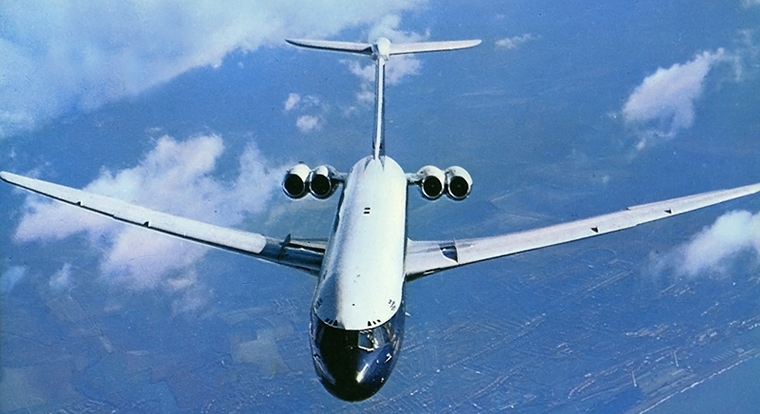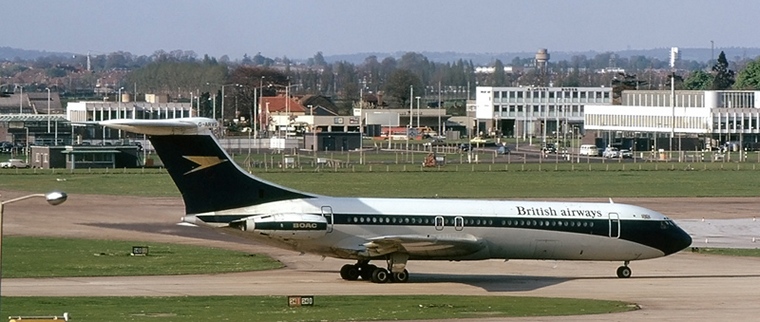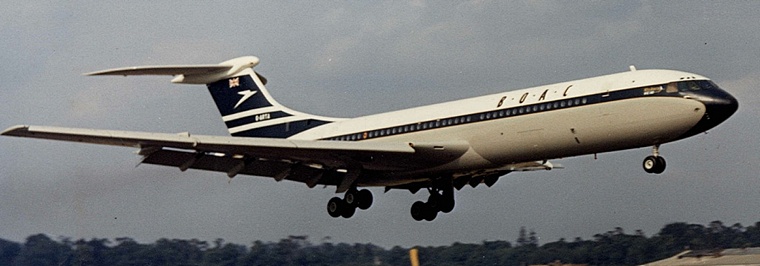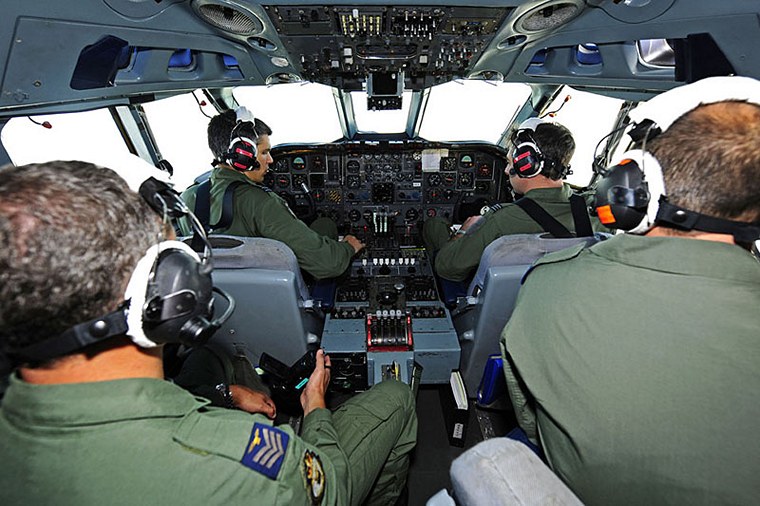Swift and Sexy - the Amazing VC10
By Bob Allison
I was watching a news item reporting Prince William's arrival for duty in the Falklands. And there, in the background, was an aircraft I thought I recognised… It took me back to my first encounter with this fabulous machine.
My introduction to the VC10 was in May 1966 on my way to Tripoli, Libya. It was the first commercial airliner I had ever travelled on. My impression was the same as all its devotees; what a lovely aircraft. Being employed by a BOAC subsidiary and before hi-jacking was a serious factor; I spent quite some time at the sharp end with the crew. They were eager to explain the virtues of their aircraft. It was impressive; a very roomy flight deck with really advanced avionics. It had a quadruplicated flight control system intended to enable fully automatic landings in zero vis. And this before the days of CATIII ILS.

The fabulous VC10 in flight
The VC10's origins stemmed from a Ministry of Supply specification for an RAF long range strategic jet transport. A development contract was awarded to Vickers for five airframes. BOAC's management was interested in the concept, which was loosely based on the Valiant bomber. The design was similar to the De Havilland Comet layout with engines buried in the wing roots. However, in its inimitable fashion, the government cancelled the contract before the design phase was complete. By this stage, though, BOAC had drawn up its own design requirements and asked Vickers to start development.
British governments and, to some extent, their national airline executives, have an uncanny penchant for shooting themselves in the foot. Commercially, at any rate. There was even a leader of the opposition called Foot. Though he was, politically, a bit of a tit.

RAF Vickers. Photo Chris Lofting / commons.wikimedia.org
By now it was the mid '50s and the US had two transatlantic jet transport designs nearing completion. Too late and too early sums up the VC10's commercial chronology. The BOAC specifications were for an aircraft which would serve the Commonwealth air routes. Africa and Asia hot and high short runways were to be its playground. And, of course, the short sighted BOAC management actually stipulated it was definitely not interested in an aircraft with transatlantic range. Around this period there were several changes to BOAC's board and senior executives. They may have been good businessmen but they understood little about airline operations.
I don't want to give the impression here that my opinion of BOAC's aircrews and technicians is as low as my view of their management. Far from it. I have always held in very high regard their aircrews and maintenance standards.
Vickers' design was stunning. A beautifully slim fuselage, clean gracefully swept wings, a T-tail. Four 22 500lb thrust Rolls Royce Conways mounted in pairs either side of the rear fuselage completed the futuristic appearance of this airliner. It wasn't just good looking, either. The stylish wing had automatic leading-edge slats, split ailerons, upper wing air brakes and enormous Fowler flaps. A wing for all seasons, so to speak. It accommodated high altitude (ceiling 43 000') high Mach number flight (.86 - 495kt) and an approach speed of only 125kt with 45° of flap.
Despite the fact that the VC10 had been designed to BOAC's specification, they then decided they needed a bigger version. Not with transatlantic range, you understand, that was not required but it must carry a bigger payload. Vickers set to work and designed a stretched version 28ft longer than the original, which they called the Super VC10. This had a max passenger load of 212, 23 more than the 707. When given the price of the new version, BOAC thought it was too much and insisted the stretch should be reduced to 13ft, giving a max passenger load of 174. Fortunately, Vickers designers were astute enough to add an extra fuel tank in the fin, to give the Super comfortable transatlantic range.
It has been speculated that covert deals were being made between the British and American governments regarding air transport. At the same time as BOAC were urging Vickers to develop the VC10, they were ordering B707s. So the VC10 development went ahead with BOAC ordering 35 aircraft with options for another 20. The Air Ministry also ordered an initial five aircraft with another six the following year. Then BOAC decided to reduce their order to 12 of the standard version and 17 Supers. The RAF took up three of the cancelled aircraft, making their total order 14.

A VC10 taxying out at an airport somewhere in the Commonwealth
BOAC's bean counters calculated that the VC10's operating cost would be £4.24 per passenger mile, compared to the B707 at £4.10 ppm. They seemed to think this was very significant - it is a difference of less than 1%. What penny pinchers. Some toad (probably enticed by a pocketful of Boeing dollars) leaked the cost figures to the industry. This resulted in several orders from other airlines being cancelled. In all, only 54 VC10s were built, including the military version. No doubt Boeing and Douglas were smiling all the way to the bank.
Ironically, when the aircraft entered service, the VC10's load factors were significantly higher than the B707. Guess what? The increased load factors gave BOAC higher earnings on their VC10 fleet. Another irony was that, though they didn't want transatlantic range, the first Super VC10s schedules were London - New York. In fact, the VC10 still holds the record for an eastbound* Atlantic crossing by a subsonic airliner. The block to block time JFK to LHR was only a little over 5hr. Only the Concord was faster. And were its development problems a strangely familiar re-enactment of US sportsmanship? Uncanny!

VC 10 Photo © BAE systems
Right from the start it was a popular aircraft loved by crews and passengers alike. A real pilot's aero plane, with (in those days) avionics to die for. And the passengers loved it too. The comfort and low cabin noise level with the engines stuck up in the tail made the airliner of choice. When given the option of VC10 or B707 most opted for the VC10.
The VC10 began scheduled services with BOAC in April 1964. Four other operators bought VC10s out of the box; British United (subsequently British Caledonian), East African Airways, Ghana Airways and, of course, the RAF, who snapped up cancelled orders. Ten other operators acquired VC10s, including two middle east military arms. However, sadly, its airline service lasted only 19 years. More happily, the RAF operated 14 of them in the Air-to-Air Refuelling role. The last of these was withdrawn from service in September 2013, after 47 years' service.

With the RAF crew on the final flight
The RAF acquired 28 VC10s, only one of which remained a pure transport aircraft. A further 13 were converted from the transport role to a transport-tanker hybrid. The remaining 14 were in-flight refuelling tankers. One of the latter was deployed for re-fuelling in the Libyan crisis of 2011.
The type has had an enviable safety record. Only two VC10s in commercial operation have been involved in fatal accidents. In fact, more were lost to terrorist hi-jacks and subsequent destruction than any other cause - four in all. British United, during its 15 years of operation, never had a single fatal accident.
An unforgettable aircraft.
*The westbound Atlantic crossing record was held by the Convair 990 Coronado, which cruised at an unbelievable 520kt.
|
       |























